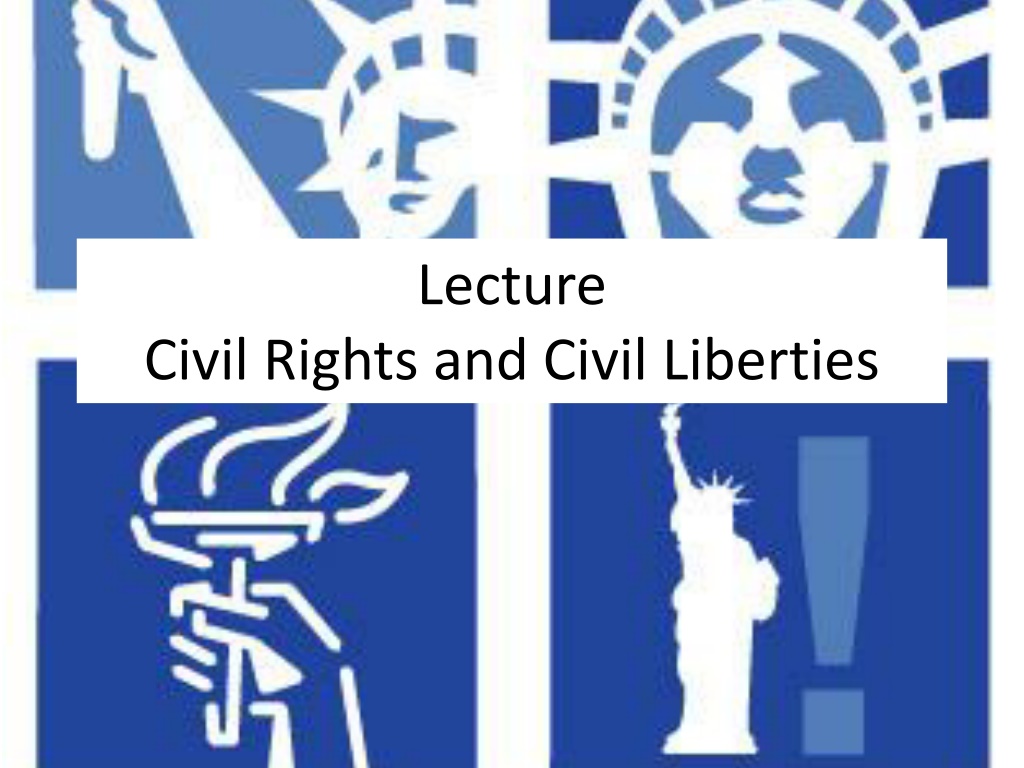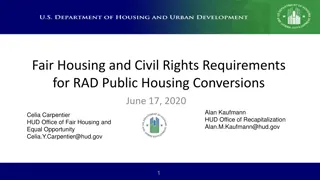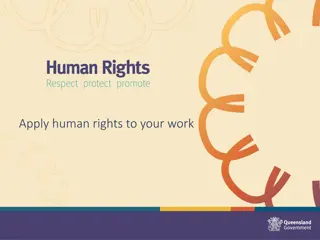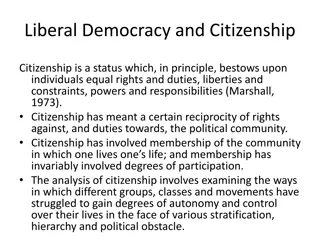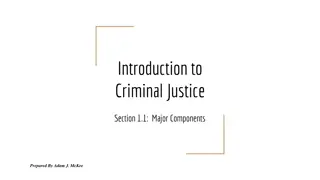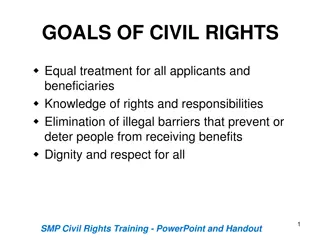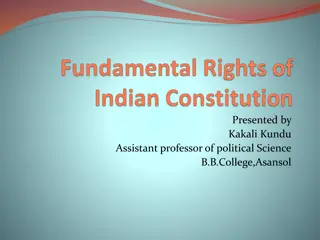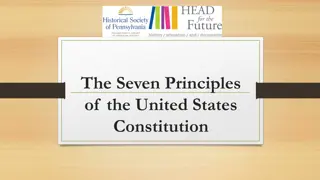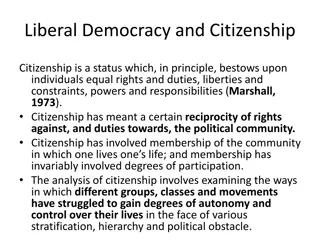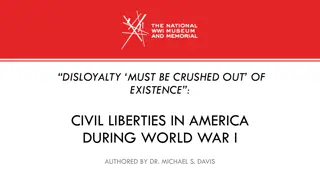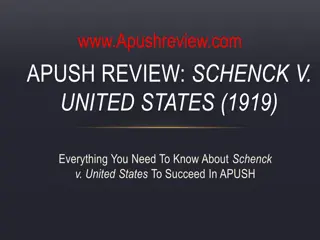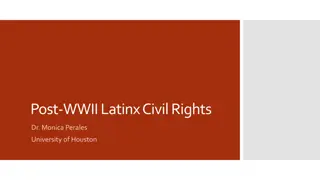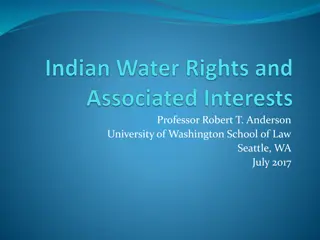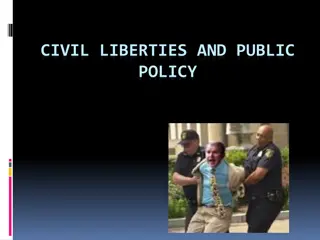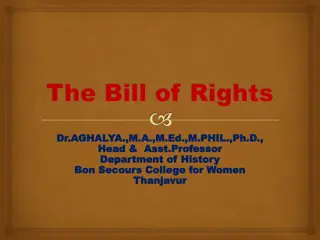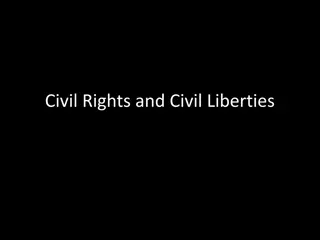Understanding Civil Rights and Civil Liberties in the United States
This educational lecture covers the definitions of civil liberties and civil rights, the historical nationalization of the Bill of Rights, and key aspects of the 1st Amendment concerning freedom of religion, the free exercise of religion, and freedom of speech and the press in American society. It explores constitutional principles and Supreme Court interpretations that shape these fundamental rights and protections.
Download Presentation

Please find below an Image/Link to download the presentation.
The content on the website is provided AS IS for your information and personal use only. It may not be sold, licensed, or shared on other websites without obtaining consent from the author. Download presentation by click this link. If you encounter any issues during the download, it is possible that the publisher has removed the file from their server.
E N D
Presentation Transcript
Lecture Civil Rights and Civil Liberties
Definition of Civil Liberties and Civil Rights Civil liberties are protections from improper government action. Some of these restraints are substantive liberties, which put limits on what government shall and shall not have the power to do. Civil rights are obligations imposed on the government to take positive action to protect citizens from any illegal action of government agencies as well as of other private citizens.
Nationalizing the Bill of Rights Initially, the Supreme Court interpreted the Bill of Rights to limit only the national government. Yet over time, the Court ruled to impose the Bill of Rights on the states and to extend it to all citizens. For example, in 1891, the Court interpreted the 14th Amendment as prohibiting the states from taking property without due process. Also, in 1925, the Court ruled that freedom of speech for all cannot be suspended without due process. Even so, it took until 1937 for the Supreme Court to nationalize civil liberties beyond the 1st Amendment.
The 1stAmendment and Freedom of Religion Separation between Church and State. The establishment clause says Congress shall make no law respecting an establishment of religion. This law means that a wall of separation exists between church and state. The wall of separation concept is subject to interpretation. Despite the establishment clause, the Supreme Court and the nation use the motto in In God We Trust on national money and one nation under God in the Pledge of Allegiance. The under God provision of the Pledge of Allegiance was challenged as a violation of the establishment clause before the Supreme Court in 2004.
The Free Exercise of Religion The free exercise clause protects a citizen s right to believe and practice whatever religion he or she chooses or to be a nonbeliever. The Supreme Court has been consistent and strict in protecting free exercise.
1stAmendment and the Freedom of Speech and of the Press Freedom of speech and of the press are fundamental values in the democratic process. Americans are assumed to have the right to speak and to broadcast their ideas unless some compelling reason can be identified to stop them. Strict scrutiny places the burden of proof on the government to show that such a reason exists. This means that some kinds of speech will be absolutely protected, but others will be conditionally protected.
Forms of Protected Speech PPolitical Speech - Expressions which comment on government action rather than the private conduct of an individual. Symbolic Speech Ex. Sit ins, burning the American flag, picketing, and demonstrations. Freedom of the Press - The press is protected under the doctrine against prior restraint (an effort by a governmental agency to block the publication of materials it deems libelous or harmful in some other way, or censorship). Libel and Slander libel (a written statement made in reckless disregard of the truth that is considered damaging to a victim because it is malicious, scandalous, and defamatory ) can be punished. Also, slander (an oral statement, made in reckless disregard of the truth that is considered damaging to a victim because it is malicious, scandalous, and defamatory ) can be punished by law. Obscenity and Pornography The Supreme Court defined obscenity as speech and writing that appeals to excite lust as it appears to the average person and is without redeeming social importance. Pornography can be regulated in restricting the production and distribution of the media through the legal doctrine called community standards. Fighting Words and Hate Speech Fighting words are defined as speech that directly incited damaging conduct and is not in the realm of protected speech. Yet they can be protected as expressive speech. Hate speech is defined as speech that is threatening or offensive to members of a particular group. Commercial Speech become increasingly protected as part of the free flow of information necessary for informed choice and democratic participation. Covers corporate speech, commercial music, movies, television, radio, and the Internet.
The 2ndAmendment A well regulated Militia, being necessary to the security of a free State, the right of the people to keep and bear Arms, shall not be infringed. The Second Amendment s purpose was to establish a militia to maintain the public order. This militia was intended to be a police force. Therefore, the people s right to keep and bear arms was associated with participation in state militias. Since the states failed to provide the arms, citizens were expected to keep their own arms ready. Current controversy over gun control has divided those who favor limitations on private ownership of guns and those who argue that such ownership is a liberty protected by the Second Amendment.
Rights of the Criminally Accused The Fourth, Fifth, Sixth, and Eighth Amendments are the essence of due process of law. Due process helps define the limits of government action against the personal liberty of citizens. The Fourth Amendment and Searches and Seizures The Fifth Amendment Grand Jury, Self Incrimination, double jeopardy. The Sixth Amendment and the Right to Counsel The Eighth Amendment and Cruel and Unusual Punishment
The Right to Privacy The Supreme Court has defined the right of privacy as the right to be left alone and to have one s own private domain, into which no one else has a right to enter without permission. The Supreme Court has held that the right to privacy protects several controversial issues such as access to birth control, abortions, homosexuality, and the right to die. Birth Control Abortion Homosexuality Right to Die
The Struggle for Civil Rights Slavery and the Abolitionist Movement The Women s Rights Movement The Civil War Amendments to the Constitution Civil Rights and the Supreme Court: Separate but Equal
The Civil Rights Acts Congress responded with a series of acts, most notably the Civil Rights Act of 1964. The 1964 act covered desegregation efforts in voting, employment, public accommodations, and education. It also declared discrimination in the workplace (private or public) illegal. Public Accommodations School Desegregation Busing Outlawing Discrimination in Employment Voting Rights Housing
The Universalization of Civil Rights Women and Gender Discrimination Latinos Mexican Americans Immigration and Civil Rights Asian Americans Native Americans Disabled Americans The Elderly Gays and Lesbians
Affirmative Action The goal of rights politics has expanded from eliminating discrimination to affirmative action (government policies or programs that seek to redress past injustices against specified groups by making special efforts to provide members of these groups with access to educational and employment opportunities). Affirmative action goals were to promote preferential treatment of minorities to foster equal opportunity and to shift national focus from desegregation to integration. Affirmative action efforts by the three branches of government were applied to the areas of health, education, welfare, and employment.
